Geological Wonders of the Hazards Mountains
Few places persist to grasp you with lasting amazement as powerfully as Freycinet National Park, on the island of Tazmania, south coast Australia. This magnificent area is a 43 km long peninsula located mid-way down the eastern shore of Tazmania, near the town of Coles Bay. The Hazards mountain range is an imposing geological formation of pink coloured granite, which plunges from sky to sea, with a fingering coastline, and occasional secluded white sand beaches, bordering clear turquoise waters.
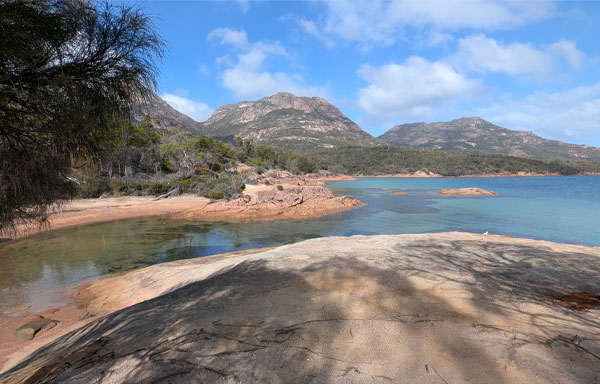
I visited Freycinet in 2016, now nine years later, I’m still awe-struck by the captivating allure of its famous barren summits. The Hazards are a range of five adjoining granite peaks, all reaching beyond 400-metres in height. They have a unique pink mineral form of feldspar, amid light quartz and dark mica. This stunning sentinel of rock grandly faces out over the Tasman Sea and Great Oyster Bay. Our view from Edge of the Bay Resort, just outside Coles Bay, is an impressive location, with a private beach overlooking the sea, facing the Hazards range. The cabin’s dramatic outlook is surrounded by a low airy forest of Banksia trees, naturally trimmed by free roaming wallabies. Wild wallabies (like small sized kangaroos) visit us around our deck each morning and evening, while they graze the scrubby woodland for tasty vegetation. Late afternoons we stroll five minutes to the beach to view broken chunks of rock strewn along the shoreline, then challenge our stamina walking in the cool sea.
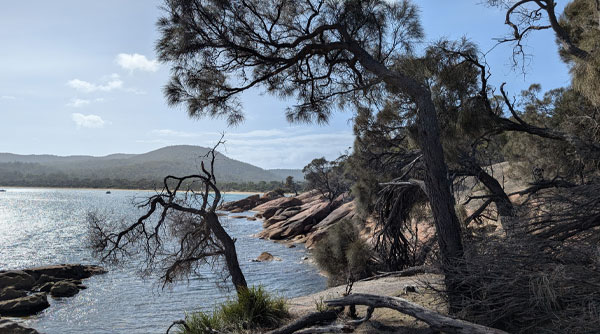
The most popular activity at Freycinet is the 45-minute hike, to a viewpoint overlooking Wineglass Bay. From a paved carpark the flat meandering pathway with occasional rock steps ascends 190 metres up to a saddle shaped exposure overlooking the bay.
The exposure, 230 metres up, allows viewers to marvel at the famous 1.7 km long, perfectly crescent-shaped white sand beach, edging an inlet of aqua waters. Walking the switchback trail from the lookout down to the beach at Wineglass Bay, the steps are steep, with technical footing, so I appreciate having my walking pole. The full circuit, from car to Wineglass Bay beach and back again, is a four-hour round-trip. We start early before the heat of the day and to be ahead of most hikers who only go to the lookout and back.
The granite headland at the Cape Tourville Lighthouse, is another remarkable location to visit. Its flat pathway leads walkers through eucalypt forest to sections of viewing platform, forty metres above the water, looking out to nearby islands and distant landforms far at sea.
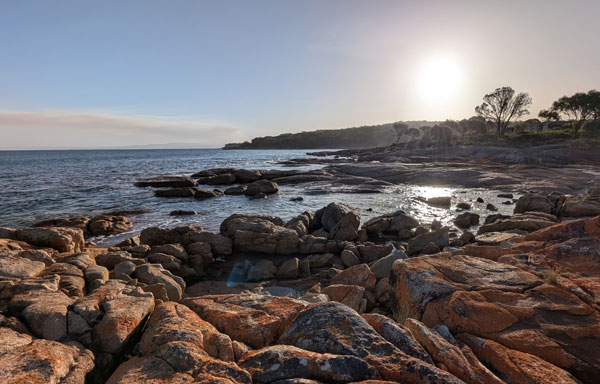
The trail at Sleepy Bay, is an uneven dirt, singletrack going through woods, following the edge of the ocean, thirty metres up. It’s rougher than other pathways, but the impressive views of faraway mountainous islands and the powerful ocean swells crashing against steep walls of rock far below are well worth the visit.
My favourite site at Freycinet is Honeymoon Bay, with its adorable tiny inlet beach, nestled amid the immense vista of pink granite, over turquoise sea. Through an almost silent lunch we rest atop smooth rock, in the dappled shade of a grand old Gum tree and gaze out spellbound across the incredible panorama surrounding us. The swim afterwards, in clear refreshing waters, deepens our memory of this majestic setting.
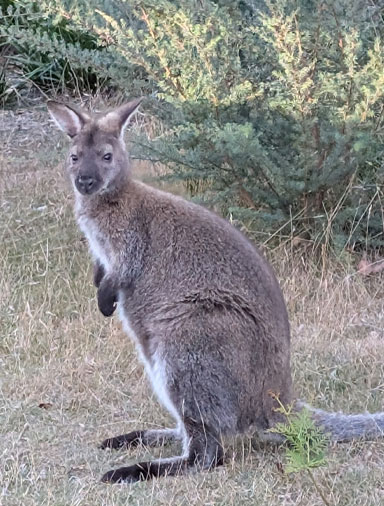
Our final day at Freycinet, we return to Wineglass Bay on a five-hour cruise boat, which operates daily from Coles Bay. The tour on a modern catamaran takes us south along the peninsula, around the perimeter edge of the mammoth Mount Freycinet peninsula, (reaching 620 metres above sea-level) through the Southern Passage, and out onto open ocean swells of the Tasman Sea. I’m thrilled to see the abundance of albatross and shearwater bird activity here as they soar over the windy three metre swells, which roll directly across from New Zealand. The boat takes us close to shore, past dramatic walls of steep rock, beside freshwater falls and adjacent to chunky rock shoreline ideal for encountering fur seal haul-out spots.
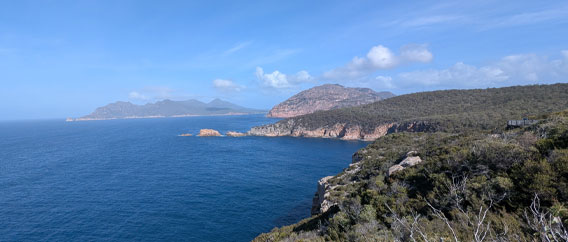
We float into tucked away bays with uninhabited secret beaches and see the section of cutaway shore where entrepreneurs once tried to commercially quarry this desirably attractive Devonian granite. Our goal is to relax in the sheltered inlet of Wineglass Bay and enjoy a floating lunch. It’s an impressive place, with sapphire waters fringing the white sand of a crescent-shaped beach, surrounded by an extraordinary mountain vista.
In celebration of our last night at Freycinet, we pick up locally caught Tasmanian Salmon and a dozen fresh oysters on the half shell, which is coupled with a bottle of Syrah from the nearby vineyard. From our cabin by the sea, hearing only the roar of waves, we reflect on this magically peaceful place. Finally, gazing into an infinity of blackness, all we see are millions of tiny white sparkles. Yes, it’s true, this is a remarkably natural environment, with possibly the freshest air in the world.
WRITER AND PHOTOGRAPHER CYNTHIA PERCIVAL

